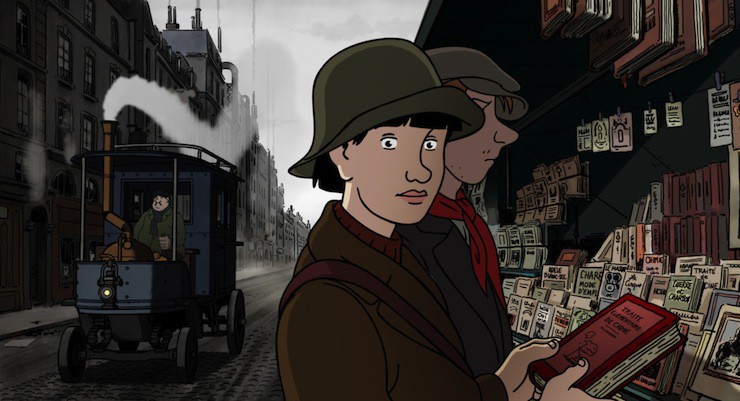Knowing what I do about the readership here at Tor.com, I’m guessing that if I say “hey, you really need to check out April and the Extraordinary World, because it’s a delightful animated adventure story about a scrappy young scientist and her talking cat, set in an alternate history steampunk France that feels like a mashup of Jules Verne, J.J. Grandville, and Hayao Miyazaki,” then—
Okay, a bunch of you are probably already gone, trying to figure out where and how and when you can see this lovely film, which just had its US premiere at Fantastic Fest. But just in case you need a little more information…
April and the Extraordinary World is the English rendering of the original French title, Avril et le monde truqué, and in fact Avril’s world is largely more truqué—twisted or broken—than extraordinary. In this alternate timeline, Napoleon III, emperor of the Second French Empire, meets an untimely end—as a result, the Franco-Prussian war never happens. This non-event transforms geopolitics, and at the same time, the great scientists of the age begin to vanish. Without the technological advances in electricity and (for better or for worse) oil that shaped our world, le monde truqué relies on steam-powered technology that first consumes the world’s coal supply, and then devastates the forests as trees are harvested and burned for charcoal. Under a polluted grey sky, the citizens wear breathing masks to get by, and wars over resources continue to drag on everywhere.

Come the year 1931, we meet Avril Franklin, daughter, granddaughter, and great-granddaughter of noted scientists. She is orphaned when her parents disappear in a airship disaster; ten years later, she has grown up to become an accomplished chemist (and fugitive), carrying on her family quest for “the ultimate serum,” a miracle cure that halts aging and reverses death. Her research leads to a surprising discovery—and then things really start to get interesting.
Working from a graphic novel originally by French comics master Jacques Tardi (who contributed his design skills to the film as well), directors Christian Desmares and Franck Ekinci and writers Ekinci and Benjamin Legrand have created an absolutely charming film. They expertly draw together multiple parallel plot threads to spin a story about scientific ambition, the bonds of family, and ecological devastation, a tale that’s also funny and deeply touching. It’s gorgeous to look at as well. The fabulously detailed steampunk Paris is a city where beauty can still be glimpsed under a layer of industrial filth; there is a dreamy fantasy forest reminiscent of Princess Mononoke and Nausicaa of the Valley of the Wind; and there’s a nod as well to Howl’s Moving Castle. And of course, it’s great to have a story that’s led by a young woman who’s intelligent, spirited, and vulnerable, perfectly voiced by Marion Cotillard.

April and the Extraordinary World is also an exuberant celebration of science, which (a certain upcoming Matt Damon movie aside) is generally a rare thing in film these days. For all that the humans have ruined the world in this alternate history, it’s clear that innovation and research is the way forward to something better. Scientific hubris isn’t the great evil here; the danger lies not in the minds of scientists like Avril and her family, but in those of the power-hungry and the violent, who seek a new weapon in every discovery and advance. In fact, the event that twisted the history of Avril’s world away from our own has its origins in Napoleon III’s desire for what amounts to super-soldiers, and in his anger when he learns that the experiments of Avril’s great-grandfather haven’t given him what he wants.
It’s not clear just yet when April and the Extraordinary World will get US distribution, but the rapturous response it’s getting at festivals suggests that it’s only a matter of time. For that matter, it can’t be too long before someone decides that the thing to do is dub it in English—in which case surely at least Cotillard can do an Anglophone reprise of her role. Whatever the case, it deserves to be seen widely and often in America; there is surely an audience for its wit and charm, and for its proof that traditional 2D animation still has—dare I say it—steam.
Karin Kross is really sorry for that. No, honest, she swears. She lives and writes in Austin, TX. She may be found elsewhere on Tumblr and Twitter.











Eh… truqué would be more “false”, or something phony, altered but to be a fraud, I think
Ah, okay. The subtitle translated it as “broken”, but I probably shouldn’t have trusted it.
On the Miyazaki reference, I’d say more Laputa, or “Castle in the Sky” than any of the three you mentioned. (Maybe a nod to the girl/boy dynamic in Nasuicaa, which is much greater in Laputa.)
Also the film’s look? Come on, Hergé, let’s be honest! This looks so much like Tintin. And the hero with his/her familiar? That’s Tintin and Snowy all over! It is looks and I hope feels more like Hergé than that so called movie that they did a couple of years ago. Many of the archetypes seemed to be nodded to as well, not least of which is Prof Calculus in that old scientist’s design.
But this looks to be an amazing film! Yes. Let me see that film now!